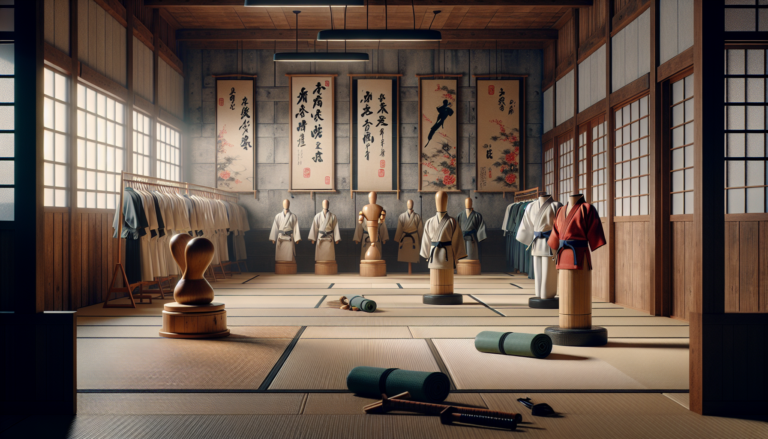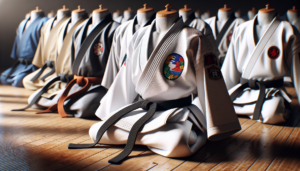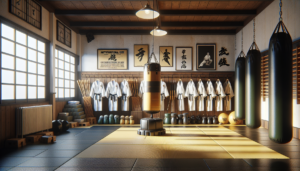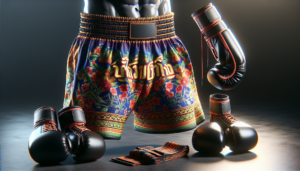Jujutsu, meaning “gentle art” in Japanese, is a revered martial art that has captivated practitioners worldwide. This ancient discipline, rooted in the battlefields of feudal Japan, has evolved into a sophisticated system of self-defense and personal growth. In this article, we will delve into the rich history, core techniques, and philosophical principles that define the essence of jujutsu.
Introduction to Jujutsu
What is Jujutsu?
Jujutsu, often referred to as the “gentle art,” is a Japanese martial art that emphasizes the use of an opponent’s force against them. Rather than relying on brute strength, jujutsu practitioners employ a variety of self-defense techniques, including joint locks, throws, and submissions, to neutralize threats and emerge victorious in confrontations.
The term “jujutsu” itself encapsulates the essence of this martial art. Written as 柔術 in Japanese, it translates to “flexible technique” or “gentle art.” This nomenclature reflects the core philosophy of jujutsu, which prioritizes adaptability, efficiency, and the strategic application of leverage over raw power.
Historical Origins of Jujutsu
The roots of jujutsu can be traced back to the tumultuous era of feudal Japan. During this period, samurai warriors often found themselves engaged in close-quarters combat, where their traditional weapons proved ineffective. In response to this challenge, various schools of jujutsu emerged, each developing unique techniques for unarmed combat.
These early jujutsu styles were closely guarded secrets, passed down from master to disciple within samurai clans. The techniques were honed on the battlefield and refined over generations, resulting in a highly effective system of self-defense that could be used against armed and unarmed opponents alike.
As Japan entered a more peaceful era, jujutsu began to spread beyond the samurai class. Schools opened their doors to the general public, allowing civilians to learn the art for personal protection and physical cultivation. This marked the beginning of jujutsu’s transition from a purely martial discipline to a means of holistic self-improvement.
Core Techniques of Jujutsu
Leverage and Balance
At the heart of jujutsu lies the principle of using an opponent’s force against them. Rather than meeting force with force, jujutsu practitioners seek to disrupt their adversary’s balance and exploit their momentum. By skillfully manipulating an opponent’s center of gravity, a smaller, weaker individual can overcome a larger, stronger attacker.
This concept of leverage is fundamental to all jujutsu techniques. Whether executing a throw, applying a joint lock, or initiating a submission, the goal is to maximize the efficiency of one’s own movements while minimizing the effectiveness of the opponent’s actions. By harnessing the power of leverage, jujutsu practitioners can achieve seemingly impossible feats of physical prowess.
Joint Locks and Throws
Jujutsu’s repertoire of techniques includes a wide array of joint locks and throws, each designed to immobilize, control, or incapacitate an opponent. Joint locks target the body’s vulnerable points, such as the elbows, wrists, shoulders, and knees. By applying pressure to these joints in specific directions, a skilled practitioner can cause pain, discomfort, or even temporary paralysis, compelling an adversary to submit.
Throws, on the other hand, involve upsetting an opponent’s balance and using their momentum to hurl them to the ground. These techniques often incorporate elements of tripping, sweeping, and lifting, combined with precise body positioning and timing. When executed properly, throws can quickly end a confrontation, leaving the attacker disoriented and vulnerable to follow-up techniques.
The beauty of jujutsu lies in its adaptability. Joint locks and throws can be seamlessly combined and transitioned, allowing practitioners to flow from one technique to another as the situation demands. This fluidity and responsiveness are what make jujutsu such a formidable and versatile system of self-defense.
Evolution and Spread of Jujutsu
Introduction to Brazil by Mitsuyo Maeda
In the early 20th century, jujutsu experienced a significant milestone that would shape its future trajectory. Mitsuyo Maeda, a renowned Japanese jujutsu practitioner, traveled to Brazil as part of a cultural exchange program. There, he encountered a young man named Carlos Gracie, who would become his most famous pupil.
Maeda, known in Brazil as “Count Koma,” taught Carlos and his brothers the intricacies of jujutsu. The Gracie family quickly recognized the effectiveness of these techniques and began to incorporate them into their own unique style of fighting. This marked the birth of Brazilian Jiu-Jitsu, a system that would later take the martial arts world by storm.
Development by the Gracie Family
Under the guidance of Carlos Gracie and his brother Helio Gracie, Brazilian Jiu-Jitsu evolved into a distinct martial art, placing a greater emphasis on ground fighting and submission holds. The Gracie family became known for their unorthodox training methods and their willingness to challenge practitioners of other styles to prove the effectiveness of their techniques.
Helio Gracie, in particular, played a crucial role in shaping Brazilian Jiu-Jitsu. Despite his small stature and frail health, Helio adapted the jujutsu techniques he learned to suit his physical limitations. He refined the art, focusing on leverage and timing, and demonstrated that a smaller, weaker opponent could overcome a larger, stronger adversary with proper technique and strategy.
Judo and Its Influence
Around the same time that Brazilian Jiu-Jitsu was taking shape, another variant of jujutsu was gaining prominence in Japan. Jigoro Kano, a brilliant educator and martial artist, had founded the art of Judo, which streamlined many of the traditional jujutsu techniques and placed a greater emphasis on sport and character development.
Kano’s Judo quickly gained popularity, both in Japan and internationally. The art’s focus on safe, controlled practice and its inclusion of a comprehensive ranking system made it accessible to a wider audience. Judo’s influence on the martial arts world cannot be overstated, as it paved the way for the development of various grappling and throwing-based styles.
While Judo and Brazilian Jiu-Jitsu share common roots in jujutsu, they have evolved in different directions. Judo tends to prioritize stand-up techniques and explosive throws, while Brazilian Jiu-Jitsu focuses more on ground fighting and submission holds. Nevertheless, both arts have contributed significantly to the growth and popularity of jujutsu-based martial arts worldwide.
Modern Practice of Jujutsu
Brazilian Jiu-Jitsu and Ground Fighting
In recent decades, Brazilian Jiu-Jitsu has emerged as one of the most prominent and influential styles of jujutsu. Its emphasis on ground fighting and submissions has revolutionized the way martial artists approach self-defense and competition.
Brazilian Jiu-Jitsu’s effectiveness lies in its ability to neutralize size and strength advantages. By taking an opponent to the ground and applying sophisticated grappling techniques, a skilled practitioner can control and submit a larger, stronger adversary. This has made Brazilian Jiu-Jitsu a foundational art for many mixed martial artists and a popular choice for self-defense-minded individuals.
The rise of Brazilian Jiu-Jitsu has also sparked a renewed interest in the original Japanese jujutsu styles. Many traditional schools have experienced a resurgence, as practitioners seek to explore the roots of this fascinating martial art. Today, jujutsu is practiced in various forms around the world, each with its unique flavor and focus.
Jujutsu in Mixed Martial Arts
The advent of mixed martial arts (MMA) competitions, such as the Ultimate Fighting Championship (UFC), has further highlighted the effectiveness of jujutsu techniques in real-world combat scenarios. MMA fighters often incorporate elements of jujutsu, particularly Brazilian Jiu-Jitsu, into their training regimens to complement their striking skills and enhance their overall grappling ability.
The success of jujutsu-based fighters in MMA has demonstrated the art’s relevance in modern combat sports. The ability to control an opponent on the ground, apply submissions, and defend against strikes has proven to be a crucial skill set in the cage. This has led to a surge in interest in jujutsu among aspiring MMA fighters and fans alike.
Philosophy and Principles of Jujutsu
Using Opponent’s Force Against Them
Beyond its technical aspects, jujutsu is deeply rooted in a philosophy of efficiency, adaptability, and self-improvement. The principle of using an opponent’s force against them, rather than relying on brute strength, encapsulates the essence of the “gentle art.”
Jujutsu teaches practitioners to blend with an attacker’s energy, redirecting and manipulating it to one’s advantage. This concept extends beyond physical confrontations and can be applied to various aspects of life. By learning to flow with adversity, adapt to changing circumstances, and use challenges as opportunities for growth, jujutsu practitioners cultivate a resilient and flexible mindset.
Adaptability and Flexibility
Another fundamental principle of jujutsu is the importance of adaptability and flexibility. The art emphasizes the need to be responsive to the ever-changing dynamics of a confrontation, both physically and mentally. Jujutsu practitioners learn to adjust their techniques and strategies based on their opponent’s actions, capitalizing on openings and exploiting weaknesses as they arise.
This principle of adaptability is reflected in the diverse range of techniques found within jujutsu. From striking and grappling to joint locks and throws, jujutsu provides a comprehensive toolset that allows practitioners to respond effectively to a wide variety of situations. By cultivating a flexible and open-minded approach, jujutsu practitioners become adept at navigating the complexities of self-defense and life itself.
At its core, jujutsu is more than just a martial art; it is a pathway to personal growth, self-discovery, and the cultivation of a resilient spirit. Through dedicated training and the embodiment of its principles, practitioners learn to face challenges with confidence, grace, and a profound understanding of the interconnectedness of all things.
In conclusion, the meaning of jujutsu extends far beyond the realm of physical technique. It is a holistic discipline that integrates the body, mind, and spirit, empowering individuals to navigate the complexities of life with skill, wisdom, and compassion. By embracing the essence of the “gentle art,” practitioners unlock their full potential, both on and off the mat.






